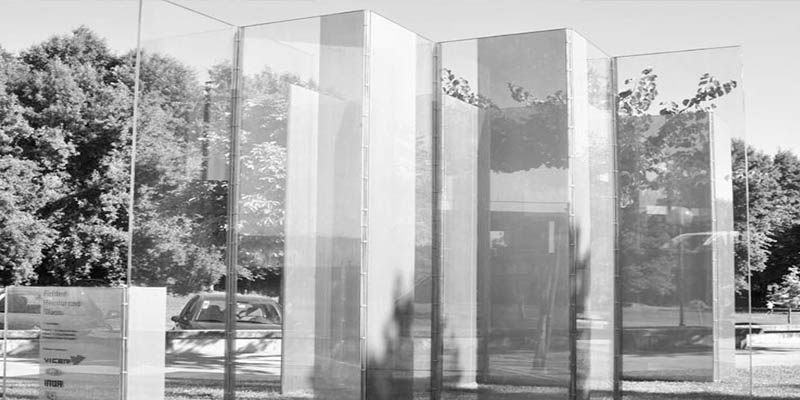Downloads
DOI:
https://doi.org/10.7480/jfde.2014.1-2.884Abstract
A reinforced glass folded structure has been developed using an innovative connection method. The concept relies on extending the reinforcement outwards from the laminated glass and using it to transfer a significant part of the load. The goal is to accomplish a glass element with high stiffness, connected by using a discrete almost invisible and easily assembled/disassembled mechanism. This paper addresses the main issues regarding the design and fabrication of a 90° folded structure, the experimental investigation of the out-of-plane compressive response and the construction of a full-scale prototype (2,95 m high and 5,5 m long) at the campus of the University of Minho. It is demonstrated that the system offers both structural and aesthetical advantages. It combines a specific aesthetic, deriving from its hybrid character, with a considerable amount of out-of-plane compressive strength before and after failure.
How to Cite
Published
Issue
Section
License
Copyright (c) 2015 Paulo L. Carvalho, Paulo J. S. Cruz, Frederic A. Veer

This work is licensed under a Creative Commons Attribution 4.0 International License.
Authors or their institutions retain copyright to their publications without restrictions.
References
Bagger, A. (2010). Plate Shell Structures of Glass. Studies Leading to Guidelines for Structural Glass. PhD Thesis, Technical University of Denmark.
Carvalho, P.L.L., Cruz, P.J.S., Veer, F.A. (2012). Connecting through reinforcement – Experimental analysis of a glass connection using perforated steel plates. Challenging Glass 3 – Conference on Architectural and Structural Applications of Glass. Delft University of Technology, Delft, The Netherlands.
Carvalho, P. L. L., Cruz, P. J. S., & Veer, F. A. (2013). Reinforced Glass Connection – Concept, test and detail. 2nd International Conference Structures and Architecture ICSA 2013, Guimarães, Portugal.
Carvalho, P. L. L. (2014). (De)materializing Detail. Technology, Structure, Design. Development of a reinforced glass connection technique (Doctoral Thesis).
Cruz, P. J. S., Veer, F. A., Carvalho, P. L. L. (2011), Perforated steel plate to laminated glass adhesive properties, GPD 2011 – Glass Performance Days International Conference, Tampere, Finland, 219-223.
Feirabend, S. (2010). Steigerung der Resttragfähigkeit von Verbundsicherheitsglas Mittels Bewehrung in Der Zwischenschicht. Universität Stuttgart, Germany.
Louter, C. (2011). Fragile yet Ductile – Structural Aspects of Reinforced Glass Beams. Delft University of Technology, Delft, The Netherlands.
Neugebauer, J. 2013. Stainless Steel Fabric as a Connection System for Bomb Blast Glass. In J. Belis, C. Louter & D. Mocibob (eds.), COST Action TU0905, Mid-Term Conference on Structural Glass (pp. 493-498). London, United Kingdom: Taylor and Francis.
O’Callaghan, J. & Bostick, C. (2012). The Apple Glass Cube: Version 2.0. In F. Bos, Ch. Louter, R. Nijsse, & Fred Veer (eds.), Challenging Glass 3 (pp. 57-65). Delft, The Netherlands: IOS Press.
O’Callaghan, J. (2007). An All Glass Cube in NY City. In Glass Performance Days, Proceedings of the 10th International conference (pp. 98-101). Tampere, Finland.
Puller, K. (2012). Untersuchung Des Tragverhaltens von in Die Zwischenschicht von Verbundglas Integrierten Lasteinleitungselementen. Universität Stuttgart, Germany.
